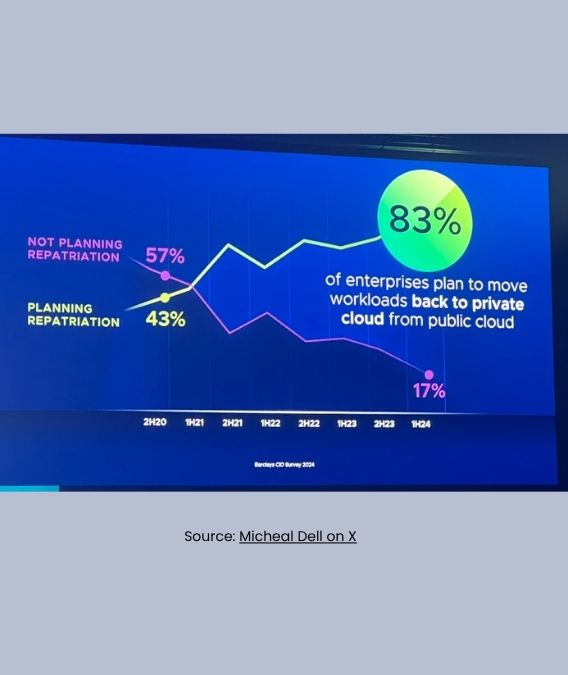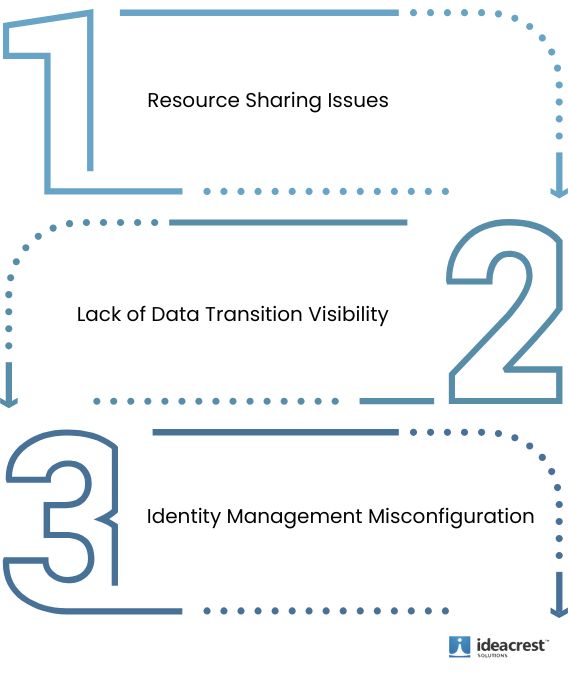Introduction
If you think it's due to AI, then you're spot on!
Since 2021, businesses have been rapidly deploying generative AI.
And by the time you read this article, chances are that more new AI trends and innovations will have emerged in the market.
As a result, you'll see businesses investing more time in conducting AI experiments to assess feasibility and improve performance and efficiency.
Now, back to the present: we're witnessing that, as organizations continue testing AI tools, they are increasingly recognizing the crucial need for highly secure and tightly controlled cloud infrastructure—i.e., a private cloud model—mainly because these experiments involve working with sensitive corporate data.
And it's not just a few industry leaders thinking this way. Many others do as well, as highlighted in the 2024 Barclays CIO Survey, which found that 83% of companies plan to move back to private cloud.

For some of our readers, this number might not come as a surprise.
If you find yourself in this category, here's an important question for you: Have you ever wondered why the public cloud is often considered less favorable during AI experiments, particularly when it comes to security?
We ask this because having clear answers to such questions can help you develop a solid cloud strategy, providing a better understanding of what to do, when to avoid certain actions, and why.
And if you've already thought along similar lines but haven't had much time to find the answers, you'll find the following sections helpful.
So, feel free to check them out.
3 Reasons Why A Public Cloud Is Less Preferred for AI Experiments

These reasons are based on our cloud market study, discussions with business leaders about their perspectives, and active listening to social media conversations on the topic:
-
Possibility of Resource Sharing Issues
In a public cloud, a third-party cloud service provider owns and operates the cloud infrastructure. Companies using this type of cloud model only have access to a portion of these resources and are considered tenants. And multiple tenants share the same cloud resources, which can lead to:
-
Contention issues
We believe explaining this term with an example will give you a clearer perspective.
So, here it is —> If one tenant consumes more cloud resources due to their AI experiments, other tenants may have to wait longer to access their own share of the resources—causing delays in output and potential reputational damage for them.
-
Increased threat surface
Let's understand this with an example —> Let's say one tenant's AI test fails and somehow compromises cloud resources. This can eventually leave other tenants vulnerable, as they share those resources, thus expanding the threat landscape.
-
Contention issues
-
Lack of Data Transition Visibility
Data in the public cloud is constantly moving, shifting from one location to another.
And organizations using this type of cloud infrastructure often have no visibility into these data movements, which complicates data security and necessitates additional protective measures.
As a result, there is a high risk of data being easily exposed to malicious actors during these transitions.
Here's an example of how things can go wrong while experimenting with AI
Let's say a company is using an AI tool to analyze sensitive customer data stored in the public cloud for some sort of predictive activities related to their sales report.
While this tool processes information, data is transferred between different geographical regions in the background.
The department is unaware of this movement, and as a result, security measures aren't planned and implemented accordingly.
This left these pieces of data exposed to potential breaches.
-
Identity Management Misconfiguration Due to Rapid Scaling
While the public cloud is easy to scale and highly flexible, achieving these benefits isn't always straightforward.
In some cases, due to rapid scaling of businesses, it becomes difficult to determine who is responsible for what and to what extent, leading to IAM (Identity and Access Management) misconfigurations.
These misconfigurations can result in system failures.
To give you a sense of the impact, Gartner research shows that system failures due to misconfigurations increased by 73% in 2023, up from 50% in 2020.
Here is a hypothetical scenario for better understanding
A new marketing department is testing an AI tool to analyze their webinar audience. This process involves using sensitive user data, like email addresses and phone numbers, which are stored in the company's public cloud.
Meanwhile, the IT team, located in a different time zone, wasn't aware of this, and as a result, IAM configurations, such as user roles and resource allocations, weren't set up properly.
This occurred due to a communication gap following the opening of a new office.
As a result, the customer data is now vulnerable and could be accessed by both unauthorized employees and external parties.
Does all of this mean you should shift to a private cloud as well?
Not necessarily. It depends on your business requirements.
For instance, you could use a private cloud for confidential testing projects and a public cloud for deployment activities, ensuring that customers worldwide can securely access your product.
This means a hybrid cloud model could also be the right choice, instead of committing to just one cloud model for all your needs.
But you can only make these decisions once you've got a solid cloud strategy in place.
And sometimes, developing a robust strategy may require expert guidance. If you find yourself requiring one, then reach out to us at info@ideacrestsolutions.com
